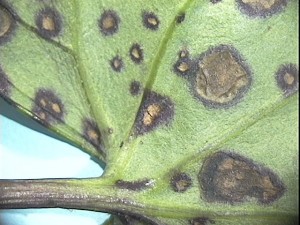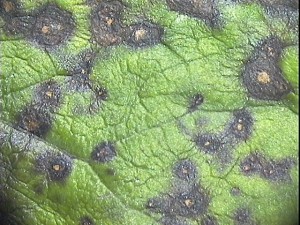Alternaria
Pathogen: Alternaria spp.
Hosts: There are several species of Alternaria that are pathogenic on perennials. Together they have a wide host range including Aster, Calendula, Coreopsis, Dianthus, Gypsophila, Helianthus, Iris, Ligularia, Pelargonium, Platycodon, Shasta, and Stokesia.
Symptoms: Dark colored leaf spots, lesions may have concentric rings within the lesion. Spots may coalesce, resulting in blighting of foliage. Petals of some plants may be infected. Flower buds of Dianthus can be rotted.
Spread: Spores are produced on the plant surface and are spread by splashing water, air movement or by moving infected plant material.
Management: Maintain adequate plant spacing to allow for good aeration to reduce humidity levels around plants. Alternaria spp. require leaf wetness for germination and infection; reduce durations of leaf wetness periods with good timing of overhead irrigation. Regular fungicide applications will likely be necessary to reduce losses on especially susceptible hosts.


Other Documents in this Series
You Might Also Be Interested In
-
MSU named Top 10 agriculture and forestry college in new report
Published on March 23, 2021
-
Michigan Sea Grant approaches Great Lakes issues with a statewide outlook and a strong local focus
Published on August 23, 2021
-
Student-led bird banding innovation spearheads continuation of data collection despite COVID-19
Published on March 16, 2021
-
MSU researchers analyzing novel technique to improve Michigan wine production
Published on June 16, 2021
-
Creating innovative models to assess spread, possible management of deadly chronic wasting disease
Published on February 1, 2021
-
A fruitful partnership
Published on September 9, 2021
Accessibility Questions:
For questions about accessibility and/or if you need additional accommodations for a specific document, please send an email to ANR Communications & Marketing at anrcommunications@anr.msu.edu.



 Print
Print Email
Email




